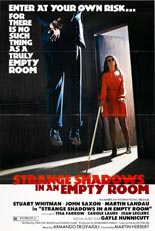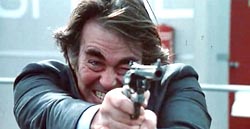
 Canada’s answer to Dirty Harry? In theory, it’s Capt. Tony Saitta, as played by the graying, mutton-chopped Stuart Whitman (Invaders of the Lost Gold) in Shadows in an Empty Room, which begins with a bank robbery and ends with a helicopter explosion, yet pains to connect the dots. The thriller is rendered bizarre not by design, but the incompetence of director Alberto De Martino (Puma Man), working under the Americanized moniker of Martin Herbert.
Canada’s answer to Dirty Harry? In theory, it’s Capt. Tony Saitta, as played by the graying, mutton-chopped Stuart Whitman (Invaders of the Lost Gold) in Shadows in an Empty Room, which begins with a bank robbery and ends with a helicopter explosion, yet pains to connect the dots. The thriller is rendered bizarre not by design, but the incompetence of director Alberto De Martino (Puma Man), working under the Americanized moniker of Martin Herbert.
Saitta is a seemingly invincible supercop with a trigger finger that’s likely been used so often, its movements now are involuntary. When his sister (Carole Laure, Naked Massacre), who is in college — and thus, young enough to be his daughter — is poisoned and declared dead on the scene by a nervous doctor (Martin Landau, Ed Wood), Saitta seeks revenge. Although a missing necklace is something of the only solid clue he has, actually solving the case feels secondary to shooting holes into people.
 Nothing wrong with a mystery, unless it’s not treated like one. De Martino wants Shadows to be everything to everyone, as it veers from crime drama to action film to giallo; not for nothing is its most common alternate title Blazing Magnum, which tonally sits on the opposite end of an Empty Room. More of a collection of scenes than a narrative, the in-shambles script includes transvestites, a little person with a French accent, a limping man, a blind roomie, a John Saxon and the erect nipples of Marlowe’s Gayle Hunnicutt.
Nothing wrong with a mystery, unless it’s not treated like one. De Martino wants Shadows to be everything to everyone, as it veers from crime drama to action film to giallo; not for nothing is its most common alternate title Blazing Magnum, which tonally sits on the opposite end of an Empty Room. More of a collection of scenes than a narrative, the in-shambles script includes transvestites, a little person with a French accent, a limping man, a blind roomie, a John Saxon and the erect nipples of Marlowe’s Gayle Hunnicutt.
Despite all those ingredients thrown into the mix without being measured, Shadows in an Empty Room wakes only for a high-speed car chase, notable because Saitta doesn’t give a fuck about the condition of his car or the safety of others. The vehicles achieve liftoff — a sight akin to striking gold, which De Martino clearly knew, because he presents it in full from a variety of angles. —Rod Lott
